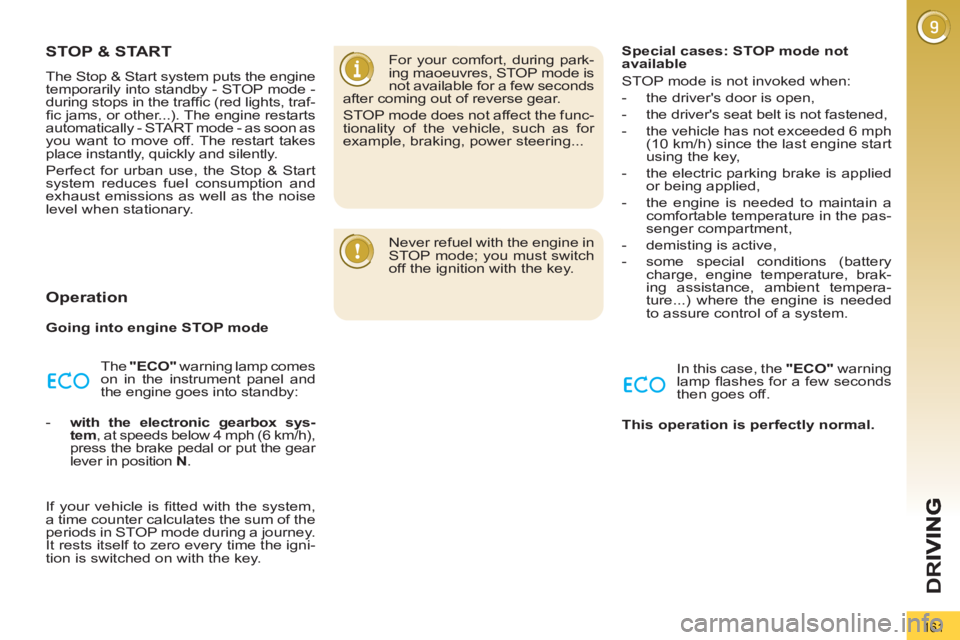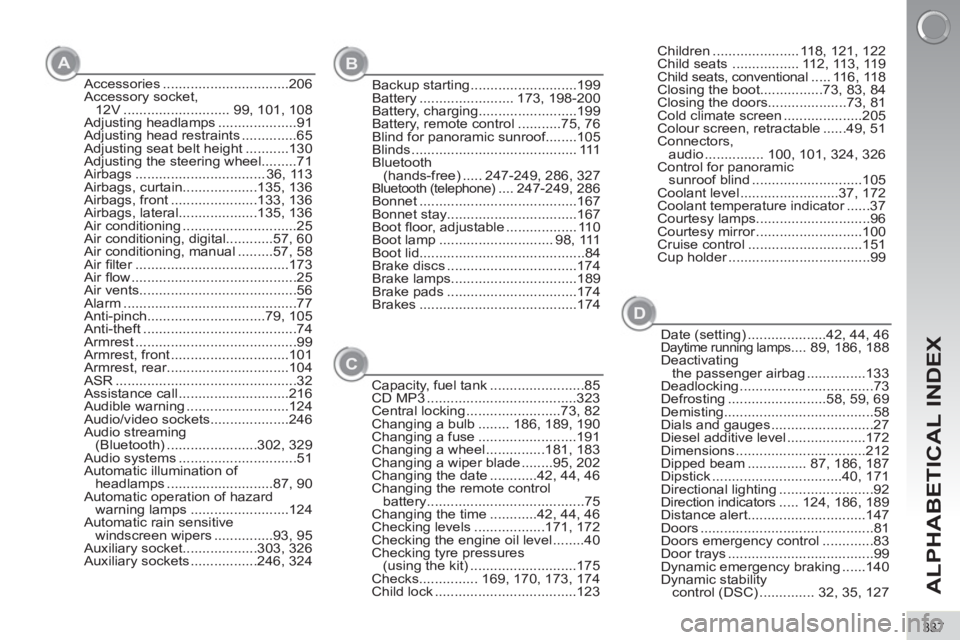2013 PEUGEOT 3008 brake light
[x] Cancel search: brake lightPage 128 of 352

126
SA
F
ELECTRONIC STABILITY PROGRAMME (ESC)
Definitions
Anti-skid regulation (ASR)
The ASR system (also known as Trac-
tion Control) optimises traction in order
to avoid wheel slip by acting on the
brakes of the driving wheels and on the
engine. It also improves the directional
stability of the vehicle on acceleration.
Dynamic stability control (DSC)
If there is a difference between the path
followed by the vehicle and that re-
quired by the driver, the DSC monitors
each wheel and automatically acts on
the brake of one or more wheels and
on the engine to return the vehicle to
the required path, within the limits of the
laws of physics.
Emergency braking assistance
In an emergency, this system enables
you to reach the optimum braking pres-
sure more quickly and therefore reduce
the stopping distance.
It is triggered in relation to the speed at
which the brake pedal is pressed. This
is felt by a reduction in the resistance of
the pedal and an increase in the effec-
tiveness of the braking.
Anti-lock braking system (ABS) and
electronic brake force distribution
(EBFD)
This system improves the stability and
manoeuvrability of your vehicle when
braking and provides improved control
in corners, in particular on poor or slip-
pery road surfaces.
The ABS prevents wheel lock in the
event of emergency braking.
The electronic brake force distribution
system manages the braking pressure
wheel by wheel.
When this warning lamp
comes on, accompanied by
an audible signal and a mes-
sage, it indicates that there
is a fault with the ABS, which
could cause loss of control of the vehi-
cle when braking.
When this warning lamp comes
on, coupled with the STOP
warning lamp, accompanied by
an audible signal and a mes-
sage, it indicates that there is a
fault with the electronic brake force dis-
tribution (EBFD), which could cause loss
of control of the vehicle when braking.
You must stop as soon as it is safe
to do so.
In both cases, contact a PEUGEOT
dealer or a qualifi ed workshop.
When changing wheels (tyres
and rims), make sure that
these are approved for your
vehicle.
Normal operation of the ABS may
make itself felt by slight vibrations of
the brake pedal.
In emergency braking, press
very fi rmly without releas-
ing the pressure.
Anti-lock braking system (ABS) and
electronic brake force distribution
(EBFD)
Electronic Stability Programme (ESC:
Electronic Stability Control) incorporat-
ing the following systems:
- the anti-lock braking system (ABS)
and the electronic brake force distri-
bution (EBFD),
- the emergency braking assistance,
- the anti-slip regulation (ASR) or
traction control,
- the dynamic stability control (DSC).
Page 162 of 352

160
D
R
I
Stopping the vehicle
Before switching off the engine, you
can engage position P
or N
to place the
gearbox in neutral.
In both cases, apply the parking brake
to immobilise the vehicle, unless it is
programmed to automatic mode.
Operating fault
When the ignition is on, the
lighting of this warning lamp,
accompanied by an audible
signal and a message in the
multifunction screen, indicates
a gearbox malfunction.
In this case, the gearbox switches to
back-up mode and is locked in 3rd gear.
You may feel a substantial knock when
changing from P
to R
and from N
to R
.
This will not cause any damage to the
gearbox.
Do not exceed 60 mph (100 km/h), local
speed restrictions permitting.
Have it checked by a PEUGEOT dealer
or a qualifi ed workshop.
This warning lamp may also come on if
a door is opened.
You risk damaging the gearbox:
Manual operation
�)
Select position M
for sequential
changing of the six gears.
�)
Push the lever towards the +
sign to
change up a gear.
�)
Pull the lever towards the -
sign to
change down a gear.
D
disappears and the gears
engaged appear in succes-
sion in the instrument panel.
If the lever is not in position P
,
when the driver's door is opened
or approximately 45 seconds af-
ter the ignition is switched off, there is an
audible signal and a message appears.
�)
Return the lever to position P
; the
audible signal stops and the mes-
sage disappears.
It is only possible to change from one
gear to another if the vehicle speed and
engine speed permit; otherwise, the
gearbox will operate temporarily in au-
tomatic mode.
Invalid value during manual
operation
This symbol is displayed if a gear
is not engaged correctly (selec-
tor between two positions).
It is possible to change from position D
(automatic) to position M
(manual) at
any time.
When the vehicle is stationary or mov-
ing very slowly, the gearbox selects
gear M1
automatically.
The sport and snow programmes do not
operate in manual mode. If the engine speed is too low or too
high, the gear selected fl ashes for a few
seconds, then the actual gear engaged
is displayed.
- if you press the accelerator and
brake pedals at the same time,
- if you force the lever from posi-
tion P
to another position when
the battery is fl at.
To reduce fuel consumption when
stationary for long periods with the
engine running (traffi c jam...), posi-
tion the gear lever at N
and apply
the parking brake, unless it is pro-
grammed in automatic mode.
Page 163 of 352

161
D
R
STOP & START
The Stop & Start system puts the engine
temporarily into standby - STOP mode -
during stops in the traffi c (red lights, traf-
fi c jams, or other...). The engine restarts
automatically - START mode - as soon as
you want to move off. The restart takes
place instantly, quickly and silently.
Perfect for urban use, the Stop & Start
system reduces fuel consumption and
exhaust emissions as well as the noise
level when stationary.
Operation
Going into engine STOP mode
The "ECO"
warning lamp comes
on in the instrument panel and
the engine goes into standby:
- with the electronic gearbox sys-
tem
, at speeds below 4 mph (6 km/h),
press the brake pedal or put the gear
lever in position N
.
If your vehicle is fi tted with the system,
a time counter calculates the sum of the
periods in STOP mode during a journey.
It rests itself to zero every time the igni-
tion is switched on with the key.
For your comfort, during park-
ing maoeuvres, STOP mode is
not available for a few seconds
after coming out of reverse gear.
STOP mode does not affect the func-
tionality of the vehicle, such as for
example, braking, power steering...
Never refuel with the engine in
STOP mode; you must switch
off the ignition with the key.
Special cases: STOP mode not
available
STOP mode is not invoked when:
- the driver's door is open,
- the driver's seat belt is not fastened,
- the vehicle has not exceeded 6 mph
(10 km/h) since the last engine start
using the key,
- the electric parking brake is applied
or being applied,
- the engine is needed to maintain a
comfortable temperature in the pas-
senger compartment,
- demisting is active,
- some special conditions (battery
charge, engine temperature, brak-
ing assistance, ambient tempera-
ture...) where the engine is needed
to assure control of a system.
In this case, the "ECO"
warning
lamp fl ashes for a few seconds
then goes off.
This operation is perfectly normal.
Page 206 of 352

204
PRACTICAL INFORMATION
TOWING A TRAILER
Your vehicle is primarily designed for
transporting people and luggage, but it
may also be used for towing a trailer.
Driving advice
The maximum towed load on a long in-
cline depends on the gradient and the
ambient temperature.
In all cases, keep a check on the cool-
ant temperature.
Side wind
�)
Take into account the increased
sensitivity to side wind.
Cooling
Towing a trailer on a slope increases
the temperature of the coolant.
As the fan is electrically controlled, its
cooling capacity is not dependent on
the engine speed.
�)
To lower the engine speed, reduce
your speed.
Braking
Towing a trailer increases the braking
distance.
To avoid overheating of the brakes on a
long mountain type of descent, the use
of engine braking is recommended.
Tyres
�)
Check the tyre pressures of the towing
vehicle and of the trailer, observing the
recommended pressures.
Lighting
�)
Check the electrical lighting and sig-
nalling on the trailer.
The rear parking sensors will
be deactivated automatically if
a genuine PEUGEOT towbar
is used.
�)
If the warning lamp and the
STOP
warning lamp come
on, stop the vehicle and
switch off the engine as
soon as possible.
Towbar suitable for the attachment of a
trailer or installation of a bicycle carrier,
with additional lighting and signalling.
Distribution of loads
�)
Distribute the load in the trailer so
that the heaviest items are as close
as possible to the axle and the nose
weight approaches the maximum
permitted without exceeding it.
Air density decreases with altitude, thus
reducing engine performance. Above
1 000 metres, the maximum towed load
must be reduced by 10 % for every
1 000 metres of altitude.
Driving with a trailer places greater de-
mands on the towing vehicle and the
driver must take particular care.
We recommend the use of
genuine PEUGEOT towbars
and their harnesses that have
been tested and approved from the
design stage of your vehicle, and that
the fi tting of the towbar is entrusted
to a PEUGEOT dealer or a qualifi ed
workshop.
If the towbar is not fi tted by a
PEUGEOT dealer, it is imperative
that it is fi tted in accordance with the
vehicle manufacturer's instructions.
Refer to the "Technical data"
section for details of the
weights and towed loads
which apply to your vehicle.
Page 210 of 352

208
TECHNICAL DATA
The GTW and towed load values indicated are valid up to a maximum altitude of 1 000 metres; the towed load mentioned
must be reduced by 10 % for each additional 1 000 metres of altitude.
The speed of a towing vehicle must not exceed 60 mph (100 km/h) (comply with the legislation in force in your country).
High ambient temperatures may result in a reduction in the performance of the vehicle to protect the engine; if the ambient
temperature is above 37 °C, limit the towed load.
PETROL WEIGHTS AND TOWED LOADS (IN KG)
*
The kerb weight is equal to the unladen weight + driver (75 kg).
**
The weight of the braked trailer can be increased, within the GTW limit, if the GVW of the towing vehicle is reduced by an
equal amount; warning, towing using a lightly loaded towing vehicle may have an adverse effect on its road holding.
***
Overseas export
Engines
1.6 litre VTi
120 hp
1.6 litre THP
156 hp
Gearboxes
Manual
(5-speed)
Manual
(6-speed)
Automatic
(6-speed)
- Unladen weight
1 399
1 459
1 480
- Kerb weight *
1 474
1 534
1 555
- Payload
621
561
- Gross vehicle weight (GVW)
2 020
2 020
2 030
- Gross train weight (GTW)
on a 12 % gradient
3 220
3 426
3 530/ 2 830 ***
- Braked trailer (within GTW limit)
on a 10 % or 12 % gradient
1 200
1 400 / 800 ***
- Braked trailer ** (with load transfer
within the GTW limit)
1 500
1 500
- Unbraked trailer
735
750
- Recommended nose weight
70
70
Page 212 of 352

210
TECHNICAL DATA
The GTW and towed load values indicated are valid up to a maximum altitude of 1 000 metres; the towed load mentioned
must be reduced by 10 % for each additional 1 000 metres of altitude.
The speed of a towing vehicle must not exceed 60 mph (100 km/h) (comply with the legislation in force in your country).
High ambient temperatures may result in a reduction in the performance of the vehicle to protect the engine; if the ambient
temperature is above 37 °C, limit the towed load.
DIESEL WEIGHTS AND TOWED LOADS (IN KG)
*
The kerb weight is equal to the unladen weight + driver (75 kg).
**
The weight of the braked trailer can be increased, within the GTW limit, if the GVW of the towing vehicle is reduced by an
equal amount; warning, towing using a lightly loaded towing vehicle may have an adverse effect on its road holding.
Engines
1.6 litre Turbo e-HDi
115 hp
2 litre Turbo
HDi
150 hp
2 litre Turbo
HDi
163 hp
Gearbox
Manual
(6-speed)
Electronic
gear control
(6-speed)
Electronic
gear control
(6-speed) Score
Manual
(6-speed)
Automatic
(6-speed)
- Unladen weight
1 421
1 529
1 539
- Kerb weight *
1 497
1 604
1 614
- Payload
609
557
566
- Gross vehicle weight (GVW)
2 030
2 086
2 105
- Gross train weight (GTW)
on a 12 % gradient
3 130
2 920
3 480
3 500
- Braked trailer (within GTW limit)
on a 10 % or 12 % gradient
1 100
890
1 400
- Braked trailer ** (with load transfer
with the GTW limit)
1 300
1 090
1 500
- Unbraked trailer
745
750
- Recommended nose weight
70
70
Page 213 of 352

211
TECHNICAL DATA
*
The kerb weight is equal to the unladen weight + driver (75 kg).
**
Exceeding the maximum rear axle weight involves a speed restriction of 50 mph (80 km/h) as defi ned in point 2.7 of the
Directive.
***
Exceeding the gross vehicle weight when the vehicle is towing involves a speed restriction of 50 mph (80 km/h) as defi ned
in point 2.7 of the Directive.
****
Maximum braked trailer weight, within the GTW limit; warning, towing using a lightly loaded towing vehicle may have an
adverse effect on its road holding.
DIESEL WEIGHTS AND TOWED LOADS (IN KG) - COMMERCIAL VEHICLES
The GTW and towed load values indicated are valid up to a maximum altitude of 1 000 metres; the towed load mentioned
must be reduced by 10 % for each additional 1 000 metres of altitude.
High ambient temperatures may result in a reduction in the performance of the vehicle to protect the engine; if the ambient
temperature is above 37 °C, limit the towed load.
Engines
1.6 litre Turbo e-HDi
115 hp
2 litre Turbo HDi
150 hp
Gearbox
es
Manual
(6-speed)
Electronic gear
control
(6-speed) Score
Electronic gear
control
(6-speed)
Manual
(6-speed)
Model codes
9HZ
9HR
9HZ
RHE
- Unladen weight
1 434
1 430
1 538
- Kerb weight *
1 509
1 505
1 613
- Gross vehicle weight (GVW) **
2 150
2 135
2 239
- Gross train weight (GTW)
on a 12 % gradient ***
3 120
2 920
3 130
3 480
- Braked trailer (within GTW limit)
on a 10 % or 12 % gradient ****
970
770
995
1 241
- Braked trailer (with load transfer
with the GTW limit)
X
X
X
X
- Unbraked trailer
750
750
- Recommended nose weight
70
70
Page 339 of 352

337
ALPHABETICAL INDEX
Accessories ................................206
Accessory socket,
12V ........................... 99, 101, 108
Adjusting headlamps ....................91
Adjusting head restraints ..............65
Adjusting seat belt height ...........130
Adjusting the steering wheel.........71
Airbags ................................. 36, 113
Airbags, curtain...................135, 136
Airbags, front ......................133, 136
Airbags, lateral....................135, 136
Air conditioning .............................25
Air conditioning, digital............57, 60
Air conditioning, manual .........57, 58
Air fi lter .......................................173
Air fl ow ..........................................25
Air vents........................................56
Alarm ............................................77
Anti-pinch..............................79, 105
Anti-theft .......................................74
Armrest .........................................99
Armrest, front ..............................101
Armrest, rear ...............................104
ASR ..............................................32
Assistance call ............................216
Audible warning ..........................124
Audio/video sockets....................246
Audio streaming
(Bluetooth) .......................302, 329
Audio systems ..............................51
Automatic illumination of
headlamps ...........................87, 90
Automatic operation of hazard
warning lamps .........................124
Automatic rain sensitive
windscreen wipers ...............93, 95
Auxiliary socket...................303, 326
Auxiliary sockets .................246, 324Capacity, fuel tank ........................85
CD MP3 ......................................323
Central locking ........................73, 82
Changing a bulb ........ 186, 189, 190
Changing a fuse .........................191
Changing a wheel ...............181, 183
Changing a wiper blade ........95, 202
Changing the date ............42, 44, 46
Changing the remote control
battery ........................................75
Changing the time ............42, 44, 46
Checking levels ..................171, 172
Checking the engine oil level ........40
Checking tyre pressures
(using the kit) ...........................175
Checks............... 169, 170, 173, 174
Child lock ....................................123Backup starting ...........................199
Battery ........................ 173, 198-200
Battery, charging .........................199
Battery, remote control ...........75, 76
Blind for panoramic sunroof........105
Blinds .......................................... 111
Bluetooth
(hands-free) ..... 247-249, 286, 327
Bluetooth (telephone) .... 247-249, 286
Bonnet ........................................167
Bonnet stay.................................167
Boot fl oor, adjustable .................. 110
Boot lamp ............................. 98, 111
Boot lid..........................................84
Brake discs .................................174
Brake lamps................................189
Brake pads .................................174
Brakes ........................................174
A
B
CChildren ...................... 118, 121, 122
Child seats ................. 112, 113, 119
Child seats, conventional ..... 116, 118
Closing the boot................73, 83, 84
Closing the doors....................73, 81
Cold climate screen ....................205
Colour screen, retractable ......49, 51
Connectors,
audio ............... 100, 101, 324, 326
Control for panoramic
sunroof blind ............................105
Coolant level .........................37, 172
Coolant temperature indicator ......37
Courtesy lamps.............................96
Courtesy mirror ...........................100
Cruise control .............................151
Cup holder ....................................99
D
Date (setting) ....................42, 44, 46Daytime running lamps .... 89, 186, 188
Deactivating
the passenger airbag ...............133
Deadlocking ..................................73
Defrosting .........................58, 59, 69
Demisting......................................58
Dials and gauges ..........................27
Diesel additive level ....................172
Dimensions .................................212
Dipped beam ............... 87, 186, 187
Dipstick .................................40, 171
Directional lighting ........................92
Direction indicators ..... 124, 186, 189
Distance alert..............................147
Doors ............................................81
Doors emergency control .............83
Door trays .....................................99
Dynamic emergency braking ......140
Dynamic stability
control (DSC) .............. 32, 35, 127